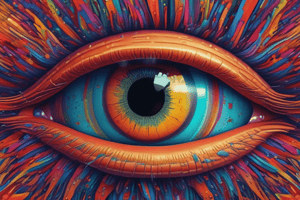Podcast
Questions and Answers
What does perception refer to?
What does perception refer to?
- The ability to remember experiences
- Only visual recognition
- Recognition of environmental stimuli
- The set of processes to make sense of sensations (correct)
What does 'distal object' mean?
What does 'distal object' mean?
It refers to the object in the external world.
What is the focus of the questions of sensation?
What is the focus of the questions of sensation?
Qualities of stimulation.
What do the questions of perception focus on?
What do the questions of perception focus on?
What do the questions of cognition focus on?
What do the questions of cognition focus on?
What is sensory adaptation?
What is sensory adaptation?
What does 'Ganzfeld' refer to?
What does 'Ganzfeld' refer to?
What are the main layers of neuronal tissue for the retina?
What are the main layers of neuronal tissue for the retina?
What are rods and cones responsible for in vision?
What are rods and cones responsible for in vision?
What does the 'what/where hypothesis' propose?
What does the 'what/where hypothesis' propose?
Which approaches describe bottom-up theories?
Which approaches describe bottom-up theories?
What are top-down theories driven by?
What are top-down theories driven by?
What are the three things percepts are based on?
What are the three things percepts are based on?
What do context effects refer to?
What do context effects refer to?
What is the law of Pragnanz?
What is the law of Pragnanz?
What are the two fundamental approaches to explaining perception?
What are the two fundamental approaches to explaining perception?
Flashcards are hidden until you start studying
Study Notes
Perception and Sensation
- Perception involves recognizing, organizing, and interpreting sensations from the environment.
- Distal object refers to an object in the external world.
- Sensation questions focus on qualities of stimulation, like color brightness.
- Perception questions focus on identity and form, asking if an object is recognized.
- Cognition questions serve further goals like determining the edibility of an object.
Sensory Adaptation
- Receptor cells undergo sensory adaptation, ceasing to respond to constant stimulation until a change occurs.
- Ganzfeld, meaning "complete field" in German, results in loss of stimulus perception when exposed to uniform fields (i.e., red surfaces).
Retina Structure
- Main retinal layers include ganglion cells, interneuron cells (amacrine, horizontal, bipolar), and photoreceptors.
- Rods are long, thin, and responsible for night vision; cones are short, thick, and enable color perception, mainly in the fovea.
Visual Pathways
- The dorsal pathway, or "where" pathway, processes location and motion; ventral pathway, or "what" pathway, processes color, shape, and identity.
Theoretical Approaches to Perception
- Bottom-up theories: perception starts with stimuli through the eyes; data-driven theories.
- Top-down theories: perception is influenced by cognitive processes and prior knowledge.
- Direct Perception (Gibson's theory): suggests environmental information is sufficient for perception, negating the need for higher cognitive processes.
- Template Theories propose stored templates for pattern recognition.
- Feature-Matching Theories focus on matching features of patterns stored in memory.
Recognition Theories
- Recognition-by-components Theory explains the perception of 3-D objects based on geometric shapes.
- Global precedence Effect indicates the ability to distinguish global features from local features.
- Constructive perception posits that cognitive processes and existing knowledge inform perception.
Contextual Effects on Perception
- Context effects demonstrate how the environment influences perception.
- Configural-superiority effect: recognizing objects in configurations is easier than isolated objects.
- Object-superiority effect: target lines are recognized better within 3-D object drawings compared to 2-D patterns.
- Word-superiority effect: identification of letters is easier in coherent words than nonsensical strings.
Representation Models
- Viewer-centered representation bases perception on individual viewpoint; shape changes with angle.
- Object-centered representation stores perceptions independent of viewer's perspective.
- Landmark-centered representation is based on relationships to familiar items.
Gestalt Principles
- Major Gestalt principles include figure-ground perception, proximity, similarity, continuity, closure, and symmetry.
- The overarching law of Pragnanz emphasizes simplicity and order in perceptual organization.
Pattern Recognition Systems
- Feature analysis system recognizes parts of objects; the configurational system specializes in larger patterns, particularly faces.
- Expert-individuation hypothesis: visual expertise activates the fusiform gyrus during object examination.
- Prosopagnosia indicates damage to the configurational system, leading to face recognition issues.
Perceptual Constancies
- Perceptual constancy is maintaining perception despite sensory changes.
- Size constancy ensures perceived size remains constant regardless of stimulus size changes.
- Shape constancy maintains perception of shape despite changes in input.
Depth Cues
- Monocular depth cues can be perceived with one eye; binocular depth cues involve information from both eyes.
Visual Impairments
- Simultagnosia: inability to focus on multiple objects simultaneously.
- Optic ataxia: impaired ability to guide movement visually, affecting reaching.
Modular Processes
- Modularity involves specialized processes for specific tasks, integrating visual and auditory experiences.
Color Vision Deficiencies
- Rod monochromacy (achromacy) indicates total color vision absence.
- Dichromacy involves one malfunctioning color perception mechanism, causing color blindness types (protanopia, deuteranopia, tritanopia).
Fundamental Approaches to Perception
- Constructive perception views perception as built from sensory data and cognitive input.
- Direct perception emphasizes immediate sensory information without needing cognitive processing.
Agnosias
- Agnosias are perceptual deficits associated with brain lesions, impacting form and pattern recognition.
Studying That Suits You
Use AI to generate personalized quizzes and flashcards to suit your learning preferences.



